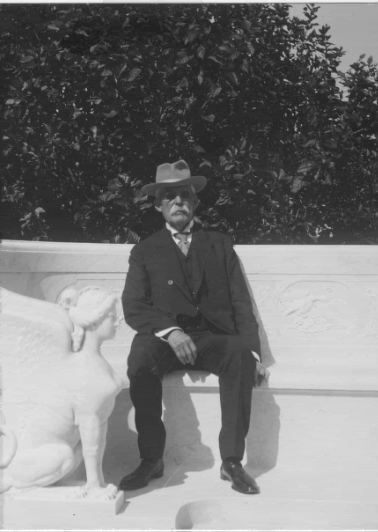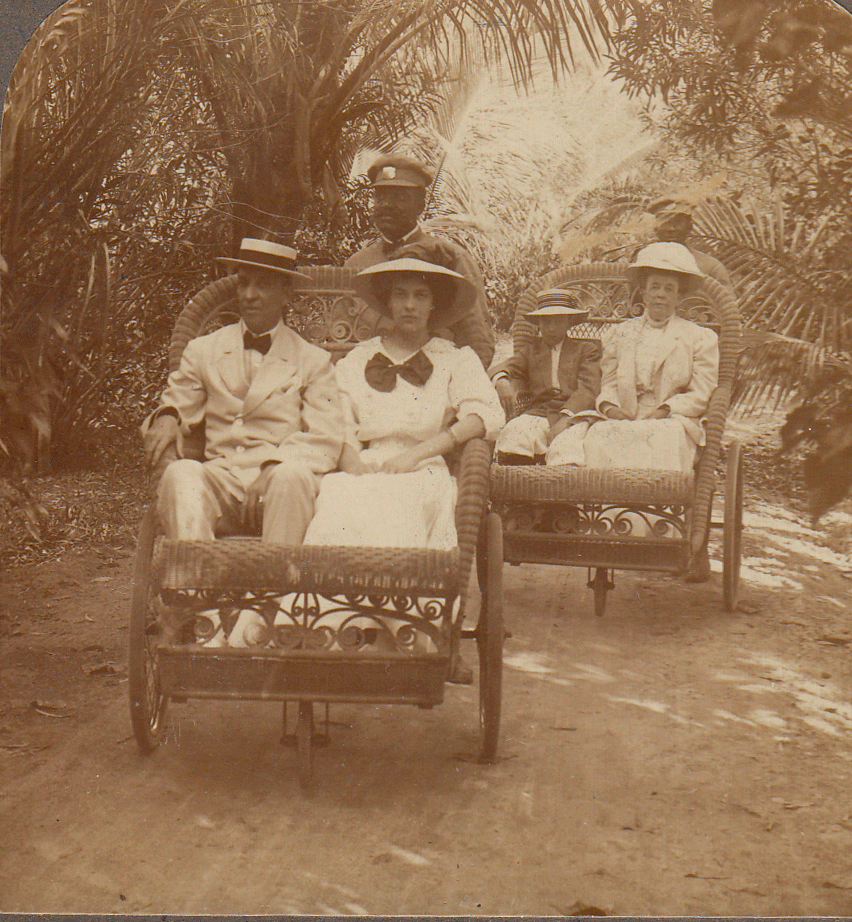Sunday
How The Other Half Bathes-1915
The same group of people seated in the foreground can also be seen here, posing amid the souvenirs at Gus' Baths. The adults are dressed in the same outfits while the two younger people have switched to bathing suits. Note that, for the young girl, proper swimming attire included a bulky cap and a heavy wool bathing dress. She's actually wearing MORE clothes than in the earlier picture!
At least four of the men in the photo are wearing identical suits so they are likely rentals (from Gus' Baths.)
The members of this party were staying at the Palm Beach Hotel which might explain why they weren't enjoying the facilities that Flagler's Breakers hotel provided a mile or so to the north.
Wednesday
Dining Room - The One That got Away
This picture, the only true color photograph of the main Dining Room that I've ever seen, was offered for sale on eBay a few years ago. Foolishly, I didn't buy it. But I did grab this lo-res copy.
The Memorial Presbyterian Church on Olive Avenue in West Palm Beach, was built entirely from the bricks of the hotel after it was demolished in 1936. It appears that much of the woodwork, windows and ornamentation came from the hotel as well.
Historians Debi Murray and Richard Marconi note that the floor of the church came from the ballroom. The dining room doubled as a ballroom when the events required more space than the octagonal ballroom could provide.
The long dining room carpet has been rolled up to make way for the waltz.
Welcome to the The Hotel Palm Beach!
The Hotel Palm Beach stood on the spot where the Biltmore (originally the Alba Hotel ) stands today. The popular hostelry met its demise in 1925 when cinders from the Breakers fire set it alight and burned it to the ground. The first three pictures were taken in 1915. The last one was taken in 1900- shortly after it opened.
Looking north from an adjacent pier in front of the hotel. Note the flags flapping on the "Skylark."
Turning the camera a few degrees to the northeast- bicycles and bicycle chairs line the lake trail in front of the hotel.
Guests were provided with this card to help with planning their daily activities. At the time these pictures were taken the only wheeled vehicles allowed on Palm Beach were the trains, mule trolley, bicycle chairs and bicycles.
A small building just out of view on the left hosted several shops including one that offered "Scientific Palmistry and Astrology." The three people gathered near the sign appear to be shop/hotel staff. The lady in the bicycle chair holds a cluster of coconuts.
You Are Here
West Palm Beach and Palm Beach in 1907- The Hotels Royal Poinciana and Breakers dominate the upper right quadrant. Just north of the Poinciana is the Hotel Palm Beach. The Jungle Trail is at the bottom. Much of the lagoon just west of the Jungle Trail was filled in and developed later.
I believe Alligator Joe's Alligator Farm was based in the lagoon at the end of the Jungle trail- not where it is labeled on the map. Alligator Joe's attraction later became The Everglades Club. Download the map for better details.
Sunday
"Welcome to Our Ocean"
Gus' Baths (later the Lido Pools) was a saltwater pool complex located on the ocean at the east end of Worth Avenue. A Danish immigrant, Gus Jordahn, opened the business in 1910- this picture was snapped in 1915- one of the earliest in existence. According to M.M. Cloutier, swimmers payed daily, weekly or monthly dues for use of the pools, picnic facilities and access to the ocean via a tunnel. Jordahn later added a 920 foot pier. Cloutier has an excellent write-up here.
Ohio tourists on their Winter holiday pose amid the conch shells (five cents each,) sea fans, coral and cloth pennants featuring Gus' famous "Welcome to Our Ocean" slogan. This picture has it all- smartly attired vacationers, a sullen pre-teen dutifully holding on to one end of the pennant and a man who is probably a lifeguard- one of Gus' fabled "Cowboys of the Sea"- in attendance.
Mystery Shirt and The Boys of Winter
In this photo, taken in 1915, the bicycle chair operator is wearing a hotel uniform complete with cap badge.
What's intriguing about the picture are the letters on his shirt
There appears to be the letters "R, P (or R,) E and an A" affixed to the front.
Is it an athletic jersey? Do the letters denote a team?
During the season, both the Royal Poinciana and Breakers Hotel fielded teams as entertainment for the guests. The diamond was located in between the hotels where the golf course is now. Players, most of whom played in the Negro League held other jobs inside the hotels. The team photo, taken in 1906 comes from the NLBPA website.
This picture, from an online auction, was taken a year after the mystery photo, a player, front row- second from the left, wears the RP uniform. Some players are wearing undershirts (the games were played in the Winter, after all!)
The Breakers team in 1915. All of these guys played in the Negro League during the regular season. More info and identity information here.
I want to believe that our guy is in one of these team photos. Unfortunately, they are too lo-res to zoom in and study.
One last tidbit from the Historical society of Palm Beach County:
During the 1920s and ‘30s, The Breakers hotel and the Royal Poinciana (until it closed) continued their tradition of hiring baseball players from the Negro Leagues to entertain their guests. The players also worked in the hotels as waiters and busboys. Several times a week, the two teams would play well-attended games on the diamond at County Road and what is now Royal Poinciana Way.
Tuesday
Ghost in the Garden
This picture is from an album I recently purchased. Stay tuned for some new, rare scenes! How about those hand-written captions!
Tea Garden
By 1915, the year this picture was taken, the Coconut Grove had taken on a Japanese theme. Later on a pagoda and paper lanterns were added to give guests the feel of a Japanese Tea Garden. Note the electric lights strung through the trees, the meandering walks and the little teashouse (center right.)
Early Ballroom
A rare view of the Hotel Royal Poinciana depicting the east side of the Ballroom (center) and a fleet of bicycle chairs and drivers.
Big Fish
The pier originally served as a port where ships unloaded cargo onto railcars. The tracks spanned the island to West Palm Beach. The tracks were used as the trolley line after the bridge was moved from the north side of Whitehall to its current location on Royal Poinciana Way.
The Hotel Royal Poinciana looms in the distance (center.) The pier was destroyed in the 1925 hurricane. Remnants are still visible on a clear day.
Wednesday
The Front Walk
A view of the grounds taken in 1903 before the east/west Piazza was built. The picture shows a view of the walk leading from the main entrance of the hotel (to the back of photographer Burr McIntosh) looking west to the docks. The portion of the walk on the right leads to the north along the front of the hotel.
This photo from the University of California, shows the same walk, about mid-way, taken from the opposite direction.
Henry Flagler- The Movie
The gentleman in this stereograph from the University of California collection is unidentified. Of course we know it's Henry Morrison Flagler sitting in front of his newly completed mansion "Whitehall." The marble bench is still there, just inside the entrance gate.
Thursday
Gibson Girls
Three young ladies, looking straight out of a Charles Dana Gibson cartoon pose on the Lake Trail in 1903. Henry Flagler's 60,000 square foot Gilded Age masterpiece, Whitehall, completed a year earlier, looms in the background.
Photo by Burr McIntosh
Monday
Dancing With the Palms
In this photograph, taken in 1903 by actor/photographer Burr McIntosh, hotel guests are seated around the dance floor in the Cocoanut Grove listening to a concert performed by the hotel band.
Sunday
On the Jungle Trail
Since learning my new trick I can't resist creating little two-frame movies from stereographs. This card depicts what appears to be a family- father and attractive daughter in the front with Mother and son close behind. The drivers, wearing tunics and badges on their caps, work for the hotel. This area appears to be the Jungle Trail- a winding, zig-zagging path that was located south of the middle bridge near the Society of the Four Arts. Alligator Joe's attraction was conveniently located at the south end of the trail where Worth Avenue is located.





























